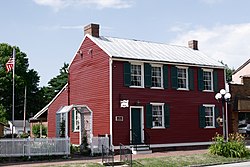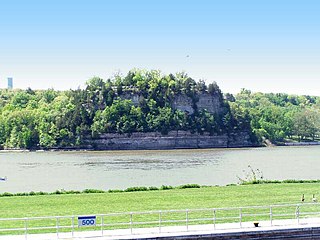
Starved Rock State Park is a state park in the U.S. state of Illinois, characterized by the many canyons within its 2,630 acres (1,064 ha). Located just southeast of the village of Utica, in Deer Park Township, LaSalle County, Illinois, along the south bank of the Illinois River, the park hosts over two million visitors annually, the most for any Illinois state park.
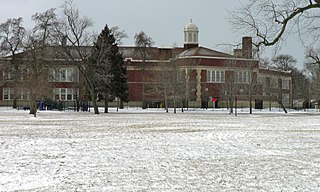
The Norwood Park Historical District is a historic district in the Norwood Park neighborhood of Chicago, Illinois. It is bordered by Bryn Mawr, Avondale, and Harlem Avenues, and is home to the Noble-Seymour-Crippen House, which was built in 1833 and is widely considered to be the oldest house in Chicago. The historic district is also home to Norwood Park Public School, William Howard Taft High School, Norwood Park, Myrtle Park, and Norwood Circle Park. The district was added to the National Register of Historic Places in 2002.
This is a list of the 128 National Register of Historic Places listings in Cook County, Illinois outside Chicago and Evanston. Separate lists are provided for the 61 listed properties and historic districts in Evanston and the more than 350 listed properties and districts in Chicago. The Chicago Sanitary and Ship Canal Historic District extends through the West Side of Chicago, DuPage County and Will County to Lockport.
There are more than 350 places listed on the United States National Register of Historic Places in Chicago, Illinois, including 83 historic districts that may include numerous historic buildings, structures, objects and sites. This total is documented in the tables referenced below. Tables of these listings may be found in the following articles:

The Magill House is a historic hotel located at 100 N. Center St. in Clinton, Illinois. Construction on the building began in 1872 and was completed in 1873. The hotel was built in order to entice the Illinois Central Railroad to move the headquarters of its Springfield Division to Clinton; the effort was successful, as the railroad moved to Clinton in the late 1870s. From its construction through the mid-20th century, the hotel was considered the finest in Clinton, and housed both Illinois Central employees and travelers on the railroad. The hotel transitioned to an apartment hotel in the 1970s, and after the late 1980s it declined and ultimately closed.

The Lebanon Historic District is a historic district composed of the areas of Lebanon, Illinois, developed prior to 1900. The district includes five distinct areas of Lebanon: the city's main commercial district, the neighborhood around McKendree University, two residential districts, and an archaeological site at the city limits. Development in Lebanon began in the 1820s, and McKendree University was founded in 1828. The oldest building from this period, the Mermaid House Hotel, is a Federal structure dating to 1830. The city received an influx of German immigrants from the 1830s onward, which affected the city's development. In the 1850s and 1860s, a railroad opened in the city and several local industries developed; however, the city retained the character of a small college town and never developed into an industrial or trade center.

The Nickels-Sortwell House is a historic house museum at 121 Main Street in Wiscasset, Maine, United States. Built in 1807 by a wealthy ship's captain, the house was designated a National Historic Landmark in 1970 as an exceptionally high-quality example of the Federal style of architecture. After serving as a hotel for much of the 19th century, the house returned to private hands in 1900. It was given to Historic New England in 1958, which gives tours of the house between May and October.
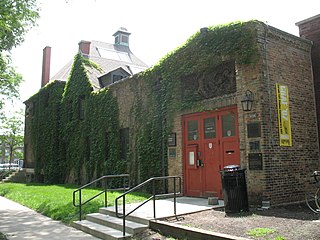
The Lorado Taft Midway Studios are a historic artist studio complex at South Ingleside Avenue and East 60th Street, on the campus of the University of Chicago on the South Side of Chicago. The architecturally haphazard structure, originating as two converted barns and a Victorian house, was used from 1906 to 1929 as the studio of Lorado Taft (1860-1936), one of the most influential sculptors of the period. A National Historic Landmark, it now houses the university's visual arts department.

Pullman National Monument, also known as The Pullman District and Pullman Historic District, is located in Chicago and was the first model, planned industrial community in the United States. The district is significant for its historical origins in the Pullman Company, one of the most famous company towns in the United States, and scene of the violent 1894 Pullman strike. It was built for George Pullman as a place to produce the famous Pullman sleeping cars.

The Arthur H. Compton House is a historic house at 5637 South Woodlawn Avenue in Chicago, Illinois. Built in 1916, it was the residence of physicist Arthur Compton (1892-1962) from the late 1920s until 1945. Compton discovered the Compton Effect in 1923, proving that light has both a particle and a wave aspect. Compton received the Nobel Prize in Physics in 1927 for this discovery. His house was designated a National Historic Landmark in 1976.

The Oscar B. Balch House is a home located in the Chicago suburb of Oak Park, Illinois, United States. The Prairie style Balch House was designed by famous architect Frank Lloyd Wright in 1911. The home was the first house Wright designed after returning from a trip to Europe with a client's wife. The subsequent social exile cost the architect friends, clients, and his family. The house is one of the first Wright houses to employ a flat roof which gives the home a horizontal linearity. Historian Thomas O'Gorman noted that the home may provide a glimpse into the subconscious mind of Wright. The Balch house is listed as a contributing property to a U.S. federally Registered Historic District.

Central House is an 1860s hotel building located in the 800-person village of Orangeville, in Stephenson County, Illinois, United States. The building was built by Orangeville founder John Bower and operated as a hotel from its construction until the 1930s, when it was converted for use as a single family residence. The three-story building was the first commercial brick structure in downtown Orangeville. Architecturally, the building is cast in a mid-19th-century Italianate style. Central House was added to the U.S. National Register of Historic Places in 1999.

The Battle House Hotel, now known as The Battle House Renaissance Mobile Hotel & Spa, is a historic hotel building in Mobile, Alabama. The current building was built in 1908 and is the second hotel to stand in this location, replacing an earlier Battle House that was built in 1852 and burned down in 1905. It is one of the earliest steel frame structures in Alabama.

The Townsend Home is a historic house located about 3 miles (4.8 km) from Stockton, Illinois, in Jo Daviess County. It is a fine example of an Upright and Wing style house with Greek Revival detailing and was completed in 1856. The house was listed on the U.S. National Register of Historic Places in 2005.
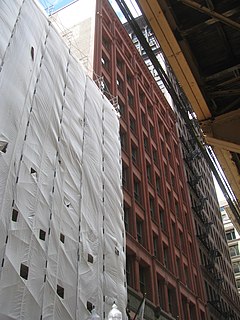
The Silversmith Hotel is a boutique hotel located in downtown Chicago, Illinois. It occupies the historic Silversmith Building, designed in 1896 by Peter J. Weber of the architectural firm of D.H. Burnham and Company, who also designed the Fisher Building. The building's architecture reflects the transition from Romanesque Revival architecture to Chicago school architecture. The Silversmith Building was listed on the National Register of Historic Places in 1997.
Currently there are 125 National Register of Historic Places listings in Central Chicago, out of 374 listings in the City of Chicago. Central Chicago includes 3 of the 77 well-defined community areas of Chicago: the historic business and cultural center of Chicago known as the Loop, as well as the Near North Side and the Near South Side. The combined area is bounded by Lake Michigan on the east, the Chicago River on the west, North Avenue on the north, and 26th Street on the south. This area runs five and one-quarter miles from north to south and about one and one-half miles from east to west.

The Fort Armstrong Theatre is an historic building located in downtown Rock Island, Illinois, United States. It opened in 1920 and was listed on the National Register of Historic Places in 1980. It was commonly referred to as the Fort Theater. The theater was named for Fort Armstrong, a fortification that sat in the middle of the Mississippi River near the present location of the Rock Island Arsenal. The building now houses a dinner theater called Circa ’21.

The Archer House Hotel is a historic hotel located at 717 Archer Ave. in Marshall, Illinois. William B. Archer, the founder of Marshall, opened the hotel in 1841. The brick hotel was one of the most lavish buildings in the city upon its opening. As a stopping point for stagecoach lines, the hotel was also the city's social center and the first place to receive out-of-town news. Archer was a Republican member of the Illinois Legislature for sixteen years and a friend and colleague of Abraham Lincoln. Lincoln regularly visited Marshall, and he stayed in the hotel during his visits. Another U.S. president, Grover Cleveland, has also stayed at the hotel.
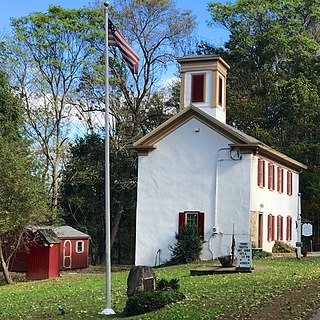
The New Hampton Historic District is a historic district in the village of New Hampton, Lebanon Township, Hunterdon County, New Jersey. The district was added to the National Register of Historic Places on April 6, 1998 for its significance in architecture, commerce, education, transportation, and community development from c. 1780 to 1929. It includes 42 contributing buildings, six contributing sites, and four contributing structures located along Musconetcong River Road.
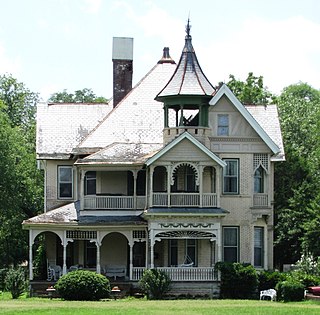
The I.W.P. Buchanan House is a historic house in Lebanon, Tennessee, U.S.. It was built circa 1894 for Isaac William Pleasant Buchanan, whose father, Dr. Andrew H. Buchanan, was the chair of the Department of Mathematics at Cumberland University. Buchanan himself taught Mathematics at Lincoln College in Illinois and co-founded the Castle Heights Military Academy in Lebanon, where he also taught Mathematics. The house was designed by architect George Franklin Barber in the Queen Anne style. It has been listed on the National Register of Historic Places since January 8, 1979.
